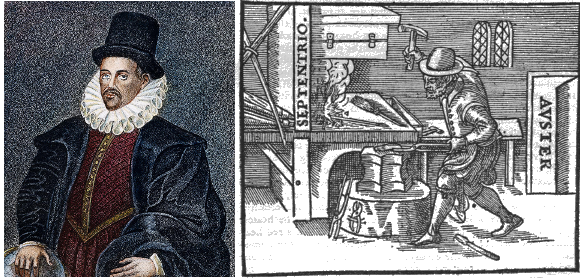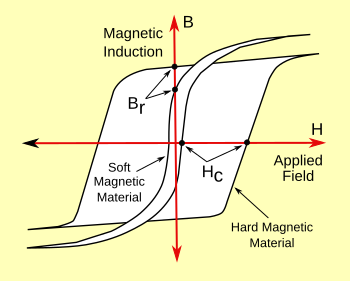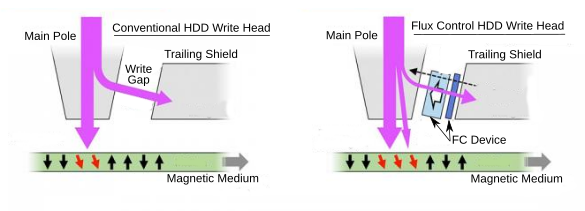Writing Magnetic Media
April 26, 2021
Rubbing a
plastic drinking straw with
most fabric materials will create an
electric charge that will attract small pieces of
paper to it. The
Coulomb's_law force of this electrical attraction is dwarfed by the
magnetic force between a
refrigerator magnet and a
steel paper clip. Such strong magnetic forces enable the
electric motors used in
industry and many
household appliances. Today's mighty motors, such as those used to raise and lower
automobile windows, use magnetic
alloys of the
rare earth elements.
A
decade ago, I wrote two articles about a major problem in the
supply chain for such
elements (
Rare Earth Shortage, June 21, 2010, and Energy Elements, May 11, 2011). The problem is that
China is the principal producer of these elements, and it has
limited their export. The US was a producer of these elements, but the
extraction of rare earths from
ore and their
purification are not that
environmentally friendly, and this led to too high a production
cost compared with that of China at that time. At this writing, the price of
neodymium metal, an important rare earth used in the most powerful
rare earth magnets, is $65/kg.
Principal rare earth elements used in magnetic alloys
While electric charge exists as separate
positive and
negative polarities,
magnets are all
dipoles with two joined
poles, named north and south after their similarity to Earth's
North Magnetic Pole and
South Magnetic Pole. This idea of the
dipole ("two-pole") magnet was established by the
research of the
English natural philosopher,
William Gilbert, who devised the first
physical model of the
magnetic Earth by creating a
sphere of
lodestone, which he called a
terrella. He showed that the magnetic
needle of a
compass moving on its
surface had the same
deflection as a compass on the Earth. The compass was known long before Gilbert's time, but not the idea that its deflection was caused by
Earth's magnetic field.

William Gilbert (1544-1603) with a woodcut from his De Magnete. The gilbert, a unit of magnetomotive force, was named in honor of Gilbert. The woodcut illustrates how hot iron can be magnetized by being worked on an anvil with its axis aligned north-south. The Latin word for North is septentrio, and the Latin word for South is avster/auster). (Gilbert portrait by Charles Henry Granger (1812-1893), via Wikimedia Commons. De Magnete Illustration no. 125, via Wikimedia Commons.)
Gilbert discovered that breaking magnets produced smaller magnets, still with a north and south pole. Gilbert's
book,
De Magnete, Magneticisque Corporibus, et de Magno Magnete Tellure (On the Magnet and Magnetic Bodies, and on That Great Magnet the Earth), was the first
treatise on
magnetism.[1] Until that time, magnetism was thought to be like
electricity, having two "fluids" which are attracted to each other.

From left to right, positive and negative electric monopoles, an electric dipole, an analogous pair of magnetic monopoles, and an actual magnetic dipole. Magnetic monopoles, which would be isolated north or south magnetic poles, have not been observed.
In the the late twentieth century there were many experiments designed to detect magnetic monopoles, since they were theorized by Dirac. There were also many failed experiments at the same time to show the existence of tachyons, which are faster than light particles. (Source images, monopoles and dipoles by Maschen, via Wikimedia Commons. Click for larger image.)
Humans were using the
natural magnet, lodestone, that Gilbert used for his terrella long before they created their own magnetic
ceramics and
alloys. Lodestones are magnetized specimens of the
mineral,
magnetite (Fe
3O
4), and these stones are attracted to themselves, and to
iron. The
Greek philosopher,
Thales, wrote about the attraction of lodestones in the
sixth century BC.
Magnetic materials were used for
data storage beginning in the
mid-20th century, first in
audio recording on magnetic metal wire, and then in
audio recording and
digital data recording on
iron oxide powder affixed to
flexible tape.
Magnetic tape recording was pioneered in the
United States by
Jack Mullin, who discovered
Magnetophon recorders in
Germany while serving in the
US Army Signal Corps during
World War II. Mullin demonstrated tape recording at a May 16, 1946, meeting of the
Institute of Radio Engineers.
The
magnetization of most
materials is
non-linear, and this is demonstrated in the material's
B-H loop, its
induction B as a function of
applied magnetic field H. This is a disadvantage for analog recording, so audio tape recorders imposed a
high frequency AC biasing on the magnetic particles during recording to reduced the
distortion caused by the
magnetic hysteresis. However, digital recording is best done on a material with extreme hysteresis and a
square-loop response.

B-H loops for a hard and soft magnetic material.
The remanence Br is the magnetization that remains in the material when the applied magnetic field is removed. The coercivity Hc is a measure of the difficulty of magnetic reversal.
A large Hc is desirable for a magnetic storage medium.
(Created using Inkscape. Click for larger image.)
Reading magnetic media is far easier than its
writing, since writing for high
areal data density requires application of a strong magnetic field in a small
area. The magnetization of materials depends on
temperature, making it easier to change its magnetic polarity, so assistive writing techniques such as
heat-assisted magnetic recording have been developed.
There's always an inducement for
innovation in writing magnetic media, since magnetic media, mostly in the form of magnetic tape, is the principal storage
technology for the world's more than 500
exabytes of data (an exabyte is 10
18 bytes).[2] Recently, a team of
Japanese scientists from the
Toshiba Corporation Corporate Research and Development Center (
Kawasaki, Japan) and the Toshiba Electronic Devices and Storage Corporation (
Yokohama, Japan) have
published an
open access paper in the
Journal of Applied Physics that describes their particular implementation of
microwave-assisted magnetic recording (MAMR).[3-4]
Modern magnetic storage media contain very small magnetic particles that allow their high storage capacity, but such small particles could be easily
demagnetized through self-demagnetization and interaction with adjacent areas, unless the magnetic coercivity is high. That results in the difficulty of recording data that microwave-assisted magnetic recording solves.[4] The particular technology for achieving this is a
spin-torque oscillator, a device that emits a
microwave field that causes the magnetically
aligned electrons in the recording medium to wobble like a
spinning top. This makes the spins easier to flip over when under the influence of the
write head.[4]
This spin-torque oscillator is positioned in the gap of the write head (see figure).[4] In this type of microwave assist, the magnetization of the gap field is completely reversed by an effect known as the
flux control effect, and this enhances the
amplitude of the magnetic
gradient of the recording field.[3-4]

Comparison between a conventional write head (left) and a flux control write head (right). The magnetization of the flux control device is reversed against the gap field in the write head. This decreases the magnetic flux inside the write head gap and increases the flux outside the write gap to assist writing. (Illustration by Hirofumi Suto, modified for clarity. Click for larger image.)
This improved writing can be used for any magnetic media and not those designed for microwave-assist.[4] A
bias current controls the flux control effect, and research showed that higher bias currents caused a faster reversal of magnetization.[4] The flux control device operates at about 3
gigabitsper
second.[3-4] Toshiba intends to introduce this writing technology into hard disk drives with 16-18
terabyte capacity.[4]
References:
- William Gilbert, "De Magnete," 1600 (original Latin); English translation. The illustration is from Book III, Chapter XII.
- Mark Lantz, "Hybrid clouds will rely on magnetic tape for decades to come," IBM Research Blog, December 15, 2020
- Hirofumi Suto, Masayuki Takagishi, Naoyuki Narita, Hitoshi Iwasaki, Tazumi Nagasawa, Gaku Koizumi, Akihiko Takeo, and Tomoyuki Maeda, "Magnetization dynamics of a flux control device fabricated in the write gap of a hard-disk-drive write head for high-density recording," Journal of Applied Physics, vol. 129, no. 10 (March 9, 2021), Article no. 103901, https://doi.org/10.1063/5.0041561. This is an open access paper with a PDF file available here.
- Flux control effect in microwave-assisted magnetic recording exploited to improve the recording field in hard disks, American Institute of Physics Press Release, March 9, 2021.
Linked Keywords: Rub; rubbing; plastic; drinking straw; triboelectric series; fabric material; electric charge; paper; Coulomb's law force; magnet; magnetic; force; refrigerator magnet; steel; paper clip; electric motor; industry; household; automobile; window; alloy; rare earth element; decade; supply chain; chemical element; energy elements; China; export limits; mining; extraction; ore; purification (chemistry); environmentally friendly; cost; neodymium; metal; rare earth magnet; lanthanum; cerium; praseodymium; samarium; europium; gadolinium; terbium; dysprosium; ytterbium; lutetium; scandium; yttrium; electrical polarity; positive; negative; magnetic dipole; pole naming convention; North Magnetic Pole; South Magnetic Pole; research; English; natural philosopher; William Gilbert; physical model; Earth's magnetic field; sphere; lodestone; terrella; compass needle; compass; surface; deflection (physics); William Gilbert (1544-1603); woodcut; gilbert (unit); magnetomotive force; iron; magnetized; hot working; anvil; north; south; Latin; Charles Henry Granger (1812-1893); Wikimedia Commons; book; De Magnete, Magneticisque Corporibus, et de Magno Magnete Tellure; treatise; magnetism; electricity; electric monopole; electric dipole moment; electric dipole; analogy; analogous; magnetic monopole; twentieth century; experiments; theoretical physics; Paul Dirac; tachyon; speed of light; faster than light; elementary particle; human; nature; natural; ceramic; alloy; mineral; magnetite; iron; Ancient Greek philosophy; Greek philosopher; Thales; sixth century BC; data storage; mid-20th century; wire recording; audio recording on magnetic metal wire; sound recording and reproduction; audio recording; digital data recording; iron oxide; powder (substance); stiffness; flexible; ribbon; tape; reel-to-reel audio tape recording; magnetic tape recording; United States; Jack Mullin; Magnetophon; Germany; US Army Signal Corps; World War II; Institute of Radio Engineers; magnetization; material; linearity; non-linear; B-field; induction; applied magnetic field; high frequency; alternating current; AC; AC bias; biasing; distortion; magnetic hysteresis; B-H loop; hard magnetic material; soft magnetic material; remanence; coercivity; magnetic storage medium; Inkscape; disk read-and-write head; areal data density; area; temperature; heat-assisted magnetic recording; innovation; technology; exabyte; Japan; Japanese; scientist; Toshiba Corporation; Kawasaki, Japan; Yokohama, Japan; scientific literature; published; open access paper; Journal of Applied Physics; microwave-assisted magnetic recording (MAMR); degaussing; demagnetized; spin-transfer torque; spin-torque; oscillation; oscillator; microwave; magnetic field; angle; align; electron; spinning top; disk read-and-write head; write head; magnetic flux; amplitude; gradient; Hirofumi Suto; bias; current; gigabit; second; terabyte.